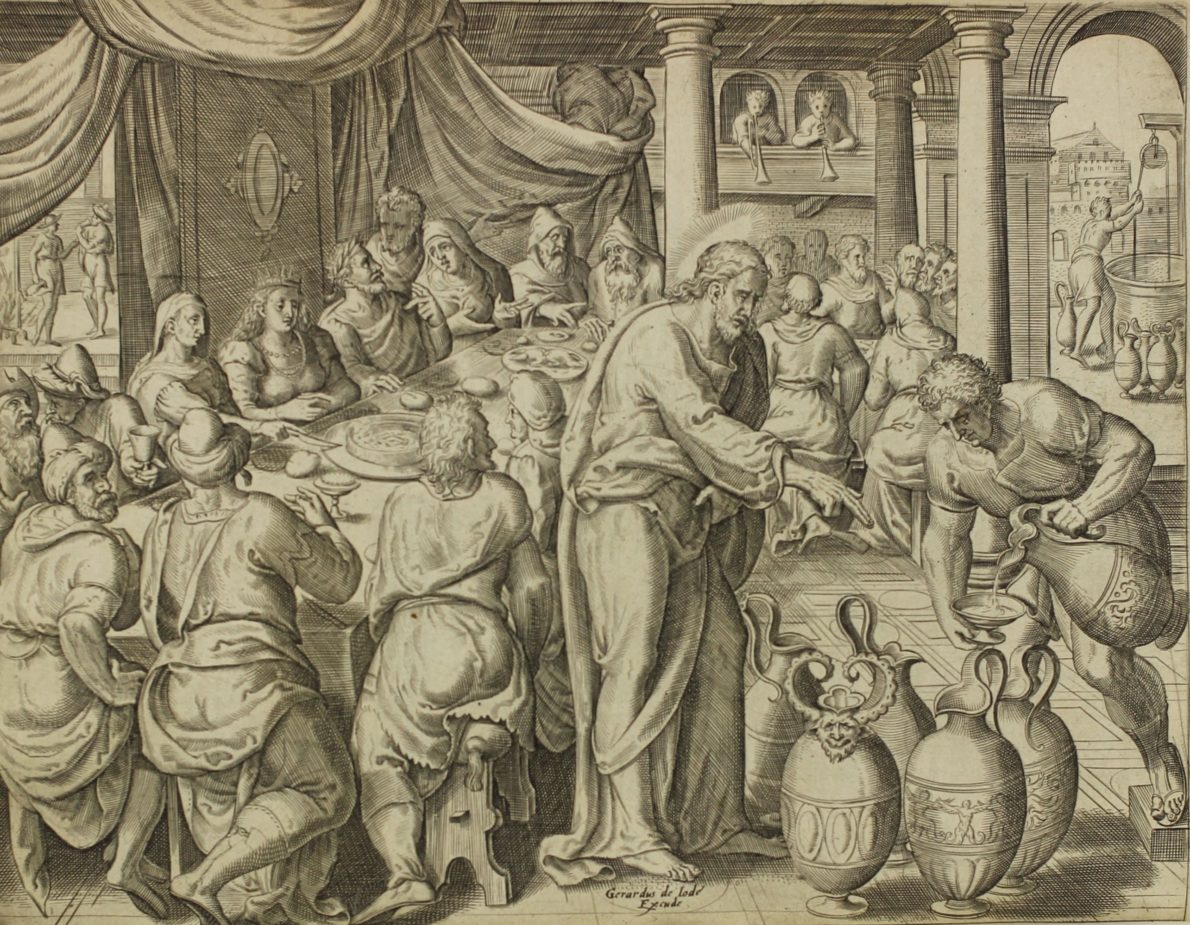Do “biblical engravings” adequately express the text to which they refer? In this engraving by Johannes Wierix (1585; found in the Hexham Abbey Bible), it is not at all clear that anything significant is going on. We might suppose that it is a wedding feast, due to the crown and laurel on the heads of the bride and bridegroom (a medieval tradition symbolizing one’s obedience to God after the manner of an original Roman tradition). But what beyond that? Supposing that Jesus is the central figure, identified by the nimbus about his head, we see that he is asking a servant to pour him a goblet of water; it is water drawn from the well in the background scene. Beyond that, we know nothing of what might be going on. Certainly, everyone else in the scene is not paying the least attention to Jesus. Of what value, then, is this engraving? Does it say anything significant, or does it simply entice us to read further? Does knowing the whole story beforehand help us to appreciate this engraving?
Note: If we know something of Jewish purification rituals, we might recognize the large jars as for that purpose only; that is, they are jars for clean water only, else they would become contaminated.
In John 2, Jesus and his mother and his disciples (possibly also his siblings) are invited to a wedding, a simple peasant wedding; Cana is close to Nazareth. During the festivities the wine begins to run out, prompting Jesus’ mother to ask him to do something about it. So Jesus tells the servants to fill the jars with water and then to offer it to the steward. The steward approves of the water-now-turned to-wine (finding it to be “good” wine rather than “poor” wine as expected at that point in the party) and it is served to the guests. According to the story, this act of Jesus was the first “sign” in which he manifested his “glory.” Are we to think, therefore, that what the story tells us and what the engraving depicts is all that we are to glean from all this, or is there more to it than what at first meets the eye? Is the miracle-sign an end in itself, or is there something far more surprising going on at this little wedding party?
The text begins with the auspicious phrase, “On the third day . . .” Which day is that? Is this merely a Semitic idiom for “a few days later” — or does it evoke another reference? All Christians will be aware that Jesus rose from the dead “on the third day” after his crucifixion and burial. Might the story’s initial phrase evoke a sense that something quite significant and astounding is about to take place? If so, how are we to recognize it?
If we follow a good rule of interpretation here, we will ask the question “What is God doing here?” Already from John 1 we will have read that, in Jesus, the “Word [of God]” (or “expression” as J. B. Phillips put it) “dwelt” among “his people” (recalling an Exodus theme); that is, Jesus is the presence of God on earth. And if we recall from the Jewish scriptures, to which the wedding guests subscribed, that the God of Israel is often referred to as the “husband” of Israel (a metaphor later picked up by Christians and applied to Jesus as the “bridegroom” of the Church), and if we are led by this metaphor to interpret the story as a wedding party between God and Israel, then we will be astounded to discover that Jesus’ “glory” here is not a simple miracle but a “sign” or demonstration that God is now giving his people a better and more abundant “wine” by which to live; and that they are now invited, by YHWH the God of Israel, to witness and to celebrate the beginning of their redemption!
All this cannot be seen in the engraving. But if one reads the story first, through the lens of the history of Israel (God as Israel’s husband) and through the lens of the crucifixion and resurrection of Jesus (Israel’s messiah-king), one might find oneself saddened by the realization that the kingdom of God was arriving, and no one noticed! So perhaps the engraving got it right after all, that at the wedding at Cana, no one noticed what Jesus was doing or in Whose name he was doing it.




